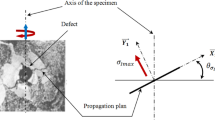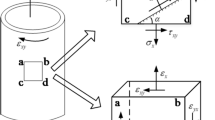Abstract
The purpose of this manuscript consists in suggesting an approach able to predict the reliability of the fatigue behavior devoted to defective material. A multiaxial high cycle fatigue criterion is adopted and improved by taking into account the 3D stress gradient effect around a defect. An equivalent multiaxial stress is figured out and reported in a useful SN curve. The proposed approach gives a more secure prediction of polycyclic fatigue behavior by coupling FE analysis and Monte Carlo reliability from which practical Iso-probabilistic SN curves are deduced. An application has been made with defective C35 steel. It has been noted that the findings are in good accord with the experimental investigation and leads to a greater reliable high cycle fatigue forecasting compared to the deterministic results. This method has also been used to analyze and discuss the impact of the defect on the fatigue behavior of the structure. This coupling Fatigue reliability gives an attractive and a strong engineering fatigue forecasting for design office.
Similar content being viewed by others
References
Quoc Huy VU (2009) Quoc Huy VU .Fatigue polycyclique multiaxiale de l’acier C35: Caractérisation et modélisation des mécanismes d’endommagement. Thèse de doctorat ENSIATA 2009
Crossland B (1956) Effect of large hydrostatic pressures on the torsional fatigue strength of an alloy steel, The international conference on fatigue of metals. Institution of mechanical engineers, London, pp 138–149
Findley WN (1959) A theory for the effect of mean stress on fatigue of metals under combined torsion and axial load or bending. ASME 426 J Eng Ind 301-306
Dang Van K (1973) Sur la résistance à la fatigue des métaux. Sciences et Technique de l'Armement 47(3):647–722
Robert JL (1992) Contribution à l'étude de la fatigue multiaxiale sous sollicitations périodiques ou aléatoires, Thèse de l'Institut National des Sciences Appliquées de Lyon
Papadopoulos IV (1994) A new criterion of fatigue strength for out-of-phase bending and torsion of hard metals. Int J Fatigue 16(6):377–384
Papuga J, et Růžička M (2008) Two new multiaxial criteria for high cycle fatigue computation. Int J Fatigue 30(1):58–66
Chakherlou TN, Mahdinia YV, Akbari A. Influence of lustrous carbon defects on the fatigue life of ductile iron castings using lost foam process. Mater Des. https://doi.org/10.1016/j.matdes.2010.06.015
Avanzini A, Petrogalli C, Battini D, Donzella G. Influence of micro-notches on the fatigue strength and crack propagation of unfilled and short carbon fiber reinforced PEEK. Mater Des. https://doi.org/10.1016/j.matdes.2017.11.039
Bo L, Shen Y, Hu W. Casting defects induced fatigue damage in aircraft frames of ZL205A aluminum alloy—a failure analysis. Mater Des. https://doi.org/10.1016/jmatdes201101.039
Nadot Y (1997) Influence des défauts de fonderie sur la résistance à la fatigue d’une fonte GS, These, ENSMA, Poitiers
Murakami Y (2002) Metal fatigue: effects of small defects and nonmetallic Inclusions, Ed. Elseiver
De Kazinczy F (1970) Effect of small defects on the fatigue properties of medium strength cast steel. J Iron Steel Inst:851–855
Ben Ahmed A, Nasr A, Bahloul A, Fathallah R (2017) The impact of defect morphology, defect size, and SDAS on the HCF response of A356-T6 alloy. Int J Adv Manuf Technol. https://doi.org/10.1007/s00170-017-0192-6
Wannes H, Nasr A, Bouraoui C (2016) New fatigue limit assessment approach of defective material under fully reserved tension and torsion loading. Mech Ind 113:310. https://doi.org/10.1051/meca/2015064
Ben Ahmed A, Nasr A, Fathallah R (2017) Probabilistic high cycle fatigue behavior prediction of A356-T6 alloy considering the SDAS dispersion. Int J Adv Manuf Technol. https://doi.org/10.1007/s00170-016-9628-7
Anouar Nasr W, Hassine CHB (2017) Fatigue limit assessment for defective materials based on affected depth. Metall Res Technol. https://doi.org/10.1051/metal/2017045
Nasr A, Bouraoui CH, Fathallah R, Nadot Y (2009) Probabilistic high cycle fatigue behaviour of nodular cast iron containing casting defects. Fatigue Fract Eng Mater Struct. https://doi.org/10.1111/j.1460-2695.2009.01330.x
Saggar M, Sallem H, Bouraoui C (2018) Fatigue life prediction under variable loading based on a new damage model devoted for defective material. Int J Adv Manuf Technol. https://doi.org/10.1007/s00170-017-1198-9
Ben Sghaier R, Bouraoui C, Fathallah R (2007) Probabilistic high cycle fatigue behaviour prediction based on global approach criteria. Int J Fatigue 29:209–221
Bouraoui C, Ben Sghaier R, Fathallah R (2009) An engineering predictive design approach of HCF behavior of shot-peened metallic parts. Mater Des 30:475–486
Seddik R, Ben Sghaier R, Atig A, Fathallah R (2017) Fatigue reliability prediction of metallic shot peened-parts based on Wöhler curve. J Constr Steel Res 130:222–233
Bahloul A et al. Probabilistic approach for predicting fatigue life improvement of cracked structure repaired by high interference fitbushing. Int J Adv Manuf Technol. https://doi.org/10.1007/s00170-016-9957-6
Nisitani H, Chen DH (1984) Stress intensity factor for a semi-elliptical surface crack in a shaft under tension. Trans Jpn Soc Mech Eng 50:1077–1082
Zhao YG, Ono T (2001) Moment for structural reliability. Struct Saf 23:47–75
Nasr A (2007) Prévision probabiliste de la tenue en fatigue polycyclique des matériaux à défauts de surface, 18ème Congrès Français de Mécanique, Grenoble
Billaudeau T (2002) Fatigue multiaxiale des matériaux à défauts : mécanisme et critère d’endurance, thèse doctorale, ENSMA, Poitiers
Gadouini H (2007) Modélisation des fatigues des matériaux contenant des défauts, thèse doctorale, ENSMA, Poitiers
Bjerager P (1991) Methods for structural reliability computation. I. In: Casciati F (ed) Reliability problems: general principles and applications in mechanics of solid and structures. Springer Verlag, New York, pp 89–136
Lemaitre M, Chateauneuf A, Mitteau JC (2005) Fiabilité des structures: couplage mécano fiabiliste statique, Edit. Hermes Paris. Cote: Rezde-chausseé, 620, 004 52 LEM
Haldar A, Mahadevan S (2000) Probability, reliability, and statistical methods in engineering design. Wiley, New York
Rackwitz R (2001) Reliability analysis: a review and some perspectives. Struct Saf 23:365–395
(2005) ABAQUS Standard User’s Manual, Version 6.10
Weibull W (1961) Fatigue testing analysis of results. Pergamon, Oxford
Author information
Authors and Affiliations
Corresponding author
Rights and permissions
About this article
Cite this article
Saggar, M., Bouraoui, C. & Nasr, A. Fatigue reliability prediction of defective materials based on a useful equivalent Wöhler curve. Int J Adv Manuf Technol 97, 1011–1021 (2018). https://doi.org/10.1007/s00170-018-1975-0
Received:
Accepted:
Published:
Issue Date:
DOI: https://doi.org/10.1007/s00170-018-1975-0




